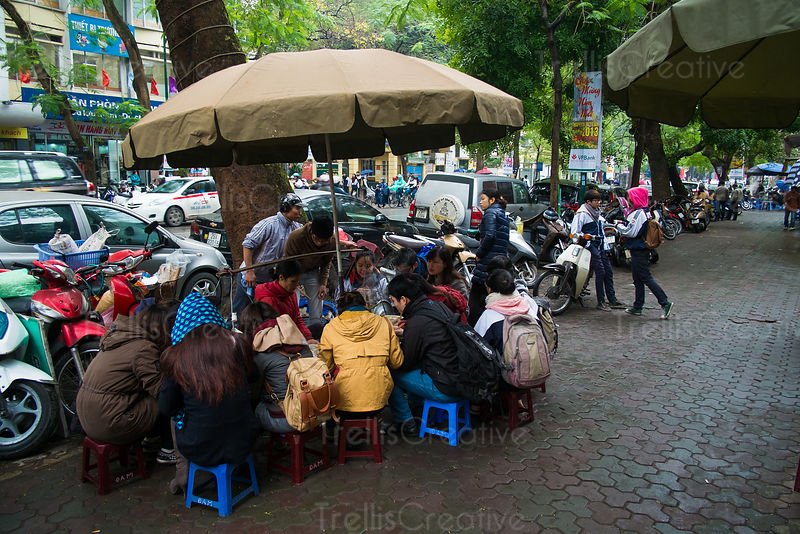One bowl at a time: Women as the backbone of the Vietnamese vendor economy
Joey Do
In major metropolis in Vietnam, it is not difficult to spot street vendors with red or blue mini plastic stools serving all sorts of foods from a steamy glossy bowl of “Bánh Canh” (noodle soup made with a thick, tapioca broth served with crab) to a fresh, crunchy “Bánh Mì” (Vietnamese baguette) filled with all kinds of meat toppings. These seemingly unorganized vendors blend in perfectly with the chaotic scenes of motorbikes, buses, and pedestrians all squeezing in one lane. In big cities, it is a normal sight to have one group of elderly meditating in proximity to another group of middle-aged aunties exercising to Vinahouse (Vietnamese-House Music) blasting at 140 bpm. And, for those who have experienced street food in Vietnam, it also comes with a unique excitement, or fear as a more accurate word, of the police raiding these food stalls because of “encroachment of the sidewalks”. As an experienced Hanoian or Saigonese, once the above happens, one would simply gather all belongings and flee with his or her food as soon as possible.
The vendor economy is an integral functioning of the Vietnamese economy and social makeup. In addition to contributing to the nation’s GDP, these establishments have become ingrained into Vietnamese life at all levels. From a gendered perspective, women play a significant role in this system, as they dominate all aspects of the vendor economy’s supply chain. Women, usually coming from nearby provinces, make up the majority of the labor force. As early as 3-4 AM, these street vendors are “awake in predawn hours of the morning to purchase fruit at a wholesale market for resale or to cook petty food to hawk on the street”.
In the post Doi Moi reform era, as Vietnam opened itself to the market economy, the emergence of women hawkers and commercialization of street vendors have brought positive changes to traditional perceptions of women. As these women improve their families’ income and livelihoods through the cultivation of these small vendors, their work is increasingly dignified. Adjectives such as entrepreneurial, assertive, diligent, and resilient, are now being extended to describing women working in these establishments. This trend is in alignment with women’s improved standing in other sectors. Overall since the 1990s, Vietnamese women are also obtaining higher education and serving in higher leadership roles in the government and corporate sector.
In all considerations, the beauty of the new market economy is that it allows the majority of women, who have yet to receive education to participate in formal employment opportunities, a chance to contribute their entrepreneurial talents with the economy. My grandmother, who is now in her 80s, was once an active participant of the vendor economy decades ago. To raise her family of six, she pedaled 50 kilometers every day to Hanoi from the nearby province of Ha Tay to sell milk cartons, fresh baguettes, and other petty food. Although she did not receive formal education due to the American War and other barriers, she was extremely efficient with basic arithmetics. She also self-taught herself to read and write. I believe that this difficult, marginal, and anxious work performed by women, like the work done by my grandmother, built the backbone of the Vietnamese vendor economy.
Another interesting aspect of the vendor economy is that it also allows these women hawkers to form coalitions, or unofficial labor unions. Acknowledging the hardships and the demanding nature of this trade, women vendor sellers are quick to form networks and friendships with other sellers for mutual benefits. In cases of mishaps, such as the frequent police raids for encroaching the sidewalks, these “coalitions” of vendor sellers could offer assistance by raising money to bail out an unlucky street vendor. Or, they could also intervene by collectively bargaining for a lower bail. All in all, the women of the street vendors have found themselves a survival mechanism, that is, power in numbers.
In the face of rigorous city planning and growing globalization, many speculate if these street vendors have what it takes to endure the near future. To different people, the answer might vary. But, with their resilience to endure hard labor, fierce competition, and the constant police raids within the past few decades, I believe that the answer is a resounding yes. As of now, many women hawkers have implemented adaptations to accommodate current trends. In major cities, vendors are now using E-wallet and online banking with QR codes to cater to younger customers in the face of digitalization.With purchases as small as 0.2 USD, customers can now scan a QR code to complete a transaction, not having to worry about carrying cash. In addition, many vendors now work alongside food shipping companies such as Grab, Gojek, and Baemin to increase their sales. These hawkers recognize that this can make their delicious, unique dishes accessible to customers who are unable to travel to the physical vendor.
Most importantly, I believe that street vendors will endure for the interpersonal connections they built, an indispensable asset to all aspects of Vietnamese social life. This is where life truly happens in Vietnam. By sitting at a local Hanoian “trà đá" (iced-tea street vendor), one can learn about world events, such as today’s oil prices, inflation rate, A-list celebrity dramas, and can even engage in hotly disputed philosophical debates. But, in an endearing way, one can also learn the great news or life events happening in any neighborhood, such as one’s kid getting into a top-tier university, or one’s daughter getting married. All of this all happens here, in small, cramped spaces on the sidewalks, in between red and blue plastic stools.



